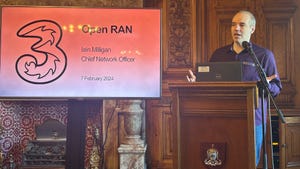Telcos ask for spectrum specifics as feds say 'stay tuned'
Over three telecom conferences in two weeks, wireless industry representatives sought clarity over spectrum plans that government representatives could not provide.

Three telecom conferences in two weeks yielded one consistent disconnect – between wireless carriers seeking details about future spectrum allocations and government representatives offering vague assurances of better bandwidth to come.
Consider the onstage quizzing of Scott Blake Harris, senior spectrum advisor and director of national spectrum strategy at NTIA, that opened ForumGlobal's 12th Americas Spectrum Management Conference in Washington on October 10.
Asked by moderator Johanne Lemay, co-president of the telco consultancy LYA, about the National Spectrum Strategy study that the Biden administration had set in motion in March, Harris provided zoomed-out answers.
"I think we're going to exceed the objective of finding spectrum to study," he said. "I think we will find more than 1500MHz of spectrum to study in the near to medium term."
He didn't speculate how much spectrum all those studies might eventually liberate for carrier use.
Nor did he break down what sorts of spectrum might be put under this NTIA microscope besides ruling out a reconsideration of the FCC's 2020 decision to keep 6GHz spectrum unlicensed to boost Wi-Fi (as he said, "good luck with that") and then reassuring the audience that "there's lots of midband spectrum that we hope to study."
Questions also abound over the lower 3GHz band. The US Department of Defense (DoD) was scheduled to release a study in September about repurposing spectrum between 3.1GHz and 3.45GHz for commercial use, but here in October that study is missing in action. "While no reason was offered for the postponement, the general speculation is that there is a continuing disagreement between the [Commerce and Defense] Departments," according to the financial analysts at New Street Research.
Finding frequencies
Industry representatives at this event, meanwhile, had shown up with spectrum shopping lists.
Umair Javed, senior vice president for spectrum at CTIA, said that trade group wants 1500MHz of licensed midband spectrum freed up and repeated its earlier requests for bands in the lower 3GHz, mid 4GHz and 7-8GHz ranges.
He suggested the Defense Department's insistence on retaining access to part of the 3.1-3.45GHz band via a spectrum-sharing regime would be acceptable, saying the DoD has already shown its willingness to share those frequencies in other parts of the world.
Javed also pitched 7-8GHz as a sort of make-good for the FCC keeping 6GHz out of the reach of wireless carriers: "7, 8GHz gets you in the same tuning range as the 6GHz band, so we will be benefiting from the economies of the scale that the rest of the world gets."
The FCC's 6GHz call, a departure from decisions of regulators elsewhere and in particular of those in China, continues to draw regrets among wireless carriers.
At a panel I moderated on October 18 at the Competitive Carriers Association's annual convention in Atlanta, UScellular general counsel and government-affairs chief Adriana Rios Welton put in a request for the commission to rewind that choice.
"6GHz, which is where the rest of the world is playing, where China is, is not currently part of the conversation in the US," she said. "And I think it needs to be if we're going to be competitive on a global stage."
(Disclosure: CCA covered my airfare and lodging in return for my moderating that panel and one other.)
Sharing is caring
Industry and government voices exhibited more harmony on the virtues of spectrum-sharing systems.
"The challenge that we have is that we are out of greenfield spectrum," said Matthew Pearl, director of emerging technology at the National Security Council, on day two of the spectrum conference. "We're all going to need to work very hard to find these dynamic, win-win solutions."
Advances in knowledge and technology, some not yet delivered, can help ease that coexistence.
"We need a lot more […] granular data by geography, power level, usage," said Michael Calabrese, a board member of the Dynamic Spectrum Alliance, speaking on the same panel as CTIA's Javed. "Often, we don't even know when parties stop using bands in certain places."
Becky Tangren, vice president and associate general counsel at NCTA, chimed in to endorse smarter "coexistence regimes" that could open up more use of such crowded frequencies as 7-8GHz and 12.7GHz and upwards.
Lessons from how iterative improvements in CBRS spectrum sharing have helped boost the number of CBRS devices in use may be instructive here.
In another talk at the spectrum-management conference, Andy Clegg, a spectrum engineering lead at Google speaking as a representative of the OnGo Alliance, touted what he called "CBRS 2.0," with more spectrum available and much less of it preempted.
For example, he explained, CBRS devices now only have to check in with a Spectrum Access System for spectrum availability every 24 hours instead of the initial five minutes, while refinements to signal-propagation algorithms should allow for smaller "dynamic protection areas."
"We've overdesigned the system to overprotect the incumbents," he said of the initial CBRS spec.
"It's imperative that we continue to iterate," agreed fellow panelist Patrick Welsh, vice president of federal regulatory and legal affairs at Verizon. "We've unlocked a lot of value from this spectrum, but there's a lot we still have to unlock."
CBRS successes
A day after ForumGlobal's event, panels at the Schools, Health & Libraries Broadband (SHLB) Coalition's AnchorNets conference in Arlington, Virginia, yielded further testimony for how CBRS has allowed connectivity to bloom even under its current constraints.
Arnold Liyai, program manager for US Ignite, recounted how a volunteer-based effort to set up CBRS basestations with microwave backhaul quickly restored access to the town of Blue River, Oregon, after a forest fire.
"That network is still up, still running," he said. "And now they think about how to expand this network beyond the school district."
Garren Shannon, director of information technology services at Pullman Public Schools in rural Whitman County, Washington, also endorsed CBRS after his experience using it to connect widely-spaced homes.
"They have no service that they can reach out to, nothing affordable," he said, calling even the local experience with SpaceX's Starlink "fairly expensive and very poor service."
Instead, he set up antenna towers on school property to relay microwave upstream links to CBRS receivers and Chromebooks in the homes of students. Noting the sparse population density, he said capacity was less of a priority than cost: "I know there is no funding for maintenance, so I look for solutions that I can maintain myself."
In a later AnchorNets panel, Harold Feld, senior vice president at Public Knowledge, commented that CBRS had done well despite deployment limits coming out of what he called a "very conservative" mindset at the FCC: "For a three-year-old technology, I would say it's doing pretty good."
Congress can still jam the airwaves
Back at ForumGlobal's event, speakers voiced confidence in the ability of government agencies to get things sorted out, citing such evidence as renewed cooperation between the FCC and NTIA after the C-band interference-risk fiasco.
"We're already seeing the fruits of these federal agencies' efforts to work well together," said Austin Bonner, deputy US chief technology officer for policy at the White House Office of Science and Technology Policy. "When we work together in this way, I suspect this kind of coexistence will become the norm."
But she also noted the offline elephant in the room: the unprecedented lapse in the FCC's spectrum-auction authority, without which all conversations about possible new band deployment will remain hypothetical. Said Bonner: "It's important that we get that auction mechanism back on track."
A week later at CCA's gathering – an event catering to small, regional carriers that may not get their calls returned quickly on Capitol Hill – speaker after speaker made similar pleas to get the FCC back in the spectrum-auction business, often followed by calls to keep the Affordable Connectivity Program funded and to cover carrier expenses to complete the "rip and replace" work of removing network gear from Huawei and other now-untrusted vendors.
But those requests sounded a little more futile after yet another week of the House itself being effectively offline after the Republican majority in the House failed multiple times to select a new Speaker of the House to replace the recently-toppled Rep. Kevin McCarthy (R.-Calif.).
Maribeth Collins, CCA's vice president of legislative affairs, joked after ruefully recapping the latest Congressional dysfunctionality: "Basically, my mother was right; I should have been an interior designer."
About the Author(s)
You May Also Like












